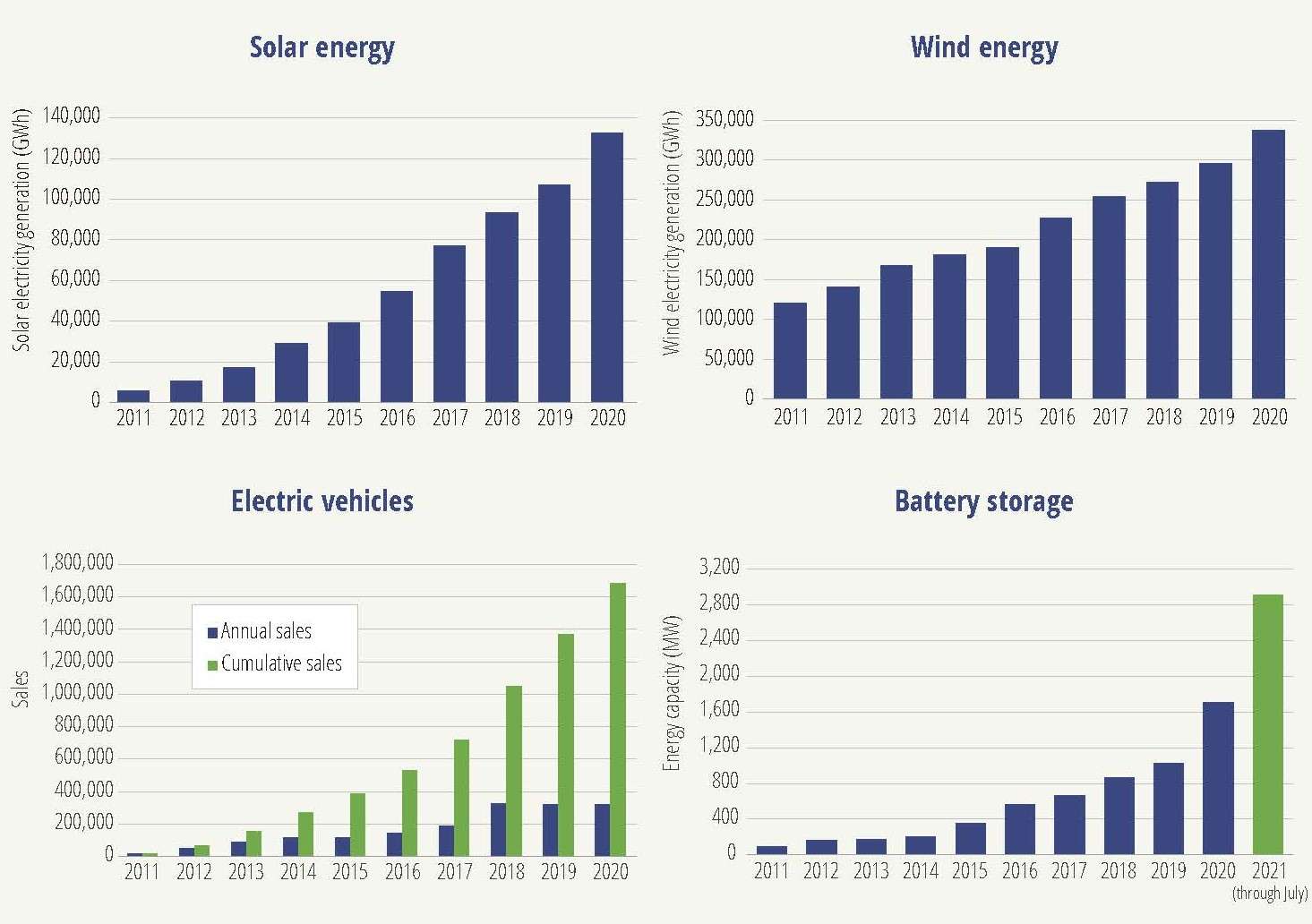Released at the tail end of last year, Environment America Research & Policy Center’s annual Renewables on the Rise report has detailed the significant progress of renewable energy sources such as solar over the past decade. The report finds that clean energy is growing rapidly across the United States, with even more dramatic growth likely in the coming years. The full report is available to download here from the YSG website, or here from the Environment America Research & Policy Center.
Renewables on the Rise 2021
Across the past decade, renewable energy sources such as solar and wind have gone from a tiny part of the energy landscape to a significant contributor. As the urgency of the climate crisis becomes more apparent, the desire to develop new clean energy solutions has grown stronger, leading to new developments in the renewable energy sector on a near-daily basis.
In 2020, the United States produced nearly 4 times more renewable energy from solar and wind than in 2011—taking solar and wind from 3% of U.S. electricity in 2011 to 11% in 2020. This exponential growth shows that an economy powered entirely by renewables is no longer a far-off dream, but a real possibility.
The annual growth rate of wind, solar, and geothermal generation between 2011 and 2020 was 15%. If this trend continues, then wind, solar, and geothermal would provide enough electricity to meet the country’s current electricity needs by 2035. The growth of renewable energy over the last decade has shown that the United States is shifting away from its dependency on fossil fuels and, with serious commitment from businesses, cities, states, and the country overall, the goal of sourcing 100% of the nation’s energy from renewable sources can be achieved.
The Growth of Clean Energy Technologies
The graphic below, courtesy of the Environment America Research & Policy Center, shows the growth of clean energy technologies in the United States between 2011 and 2020.
As you can see from the charts above, solar energy, wind energy, electric vehicles, and battery storage—the key technologies needed to power the U.S. with clean energy—have all grown significantly across the past decade. Below, we will take a closer look at the numbers behind the visuals for each of these technologies, using figures from the Renewables on the Rise 2021 report.
- Solar: As of 2020, the U.S. produces over 23 times more solar power than it did in 2011—enough to power more than 12 million typical American homes. While solar rooftops and utility-scale solar power plants produced only 0.14% of U.S. electricity in 2011, they produced 2.3% in 2020. 2019 saw the installation of the country’s 2 millionth solar PV system, with another million systems installed by summer of 2021.
- Wind: The U.S. has tripled the amount of wind power it produces since 2011, now generating enough to power over 31 million homes. In 2011, 3% of U.S. electricity came from wind energy—in 2020, that figure stood at 8.4%.
- Electric Vehicles: Only 16,000 battery and plug-in hybrid electric vehicles were sold in the United States in 2011. By December 2020, cumulative sales had grown to almost 1.7 million EVs. In the summer of 2021, electric vehicle sales nationwide had surpassed the 2 million mark.
- Battery Storage: U.S. battery storage capacity totaled 1.7 GW in 2020, growing over 18-fold from 2011 to 2020—and a staggering 67% in 2020 alone.
How Cities, States, and the Federal Government Should Accelerate the Transition to Clean Energy
Strong and supportive public policies have played a vital role in the growth of clean energy technologies so far, and the Environment America Research & Policy Center has included in their report a number of suggestions for cities, states and the federal government to continue and accelerate this growth. Below, we have briefly detailed a number of key suggestions.
- Ambitious renewable energy targets must be established. Thus far, 9 states and nearly 200 cities & towns have committed to obtaining 100% of their electricity from renewable sources within the coming decades, and it is imperative that others follow this example. Governments should also identify specific targets for the deployment of clean energy technologies such as solar power, offshore wind, and battery storage.
- Strong incentives should be made available for the adoption of renewables. This includes the extension of federal tax credits, as well as local & state clean energy incentives. Policymakers should also focus on the expansion and improvement of existing incentives to ensure that they benefit everyone who wishes to be part of the country’s clean energy future.
- It is important that utility policies offer fair compensation to investors in clean energy technologies. Utilities should also adopt policies for permitting and interconnection that streamline the deployment of clean energy technologies such as solar panels.
- Support for the integration of clean energy technologies and practices will enable the U.S. to take full advantage of its renewable energy potential. Examples of this integration include the deployment of energy storage systems alongside the grid, the development of renewably-powered local microgrids, and the expansion of transmission infrastructure.
To learn more about how you can play your part in America’s clean energy future—and save money while doing so—contact YSG Solar today. YSG has worked in the solar industry for over a decade, contributing to the renewable energy growth outlined in this article. We will identify the ideal solar solution for your energy needs and make that solution a reality. Call the office at 212.389.9215 or send us an email to learn how much you could save with solar.
YSG Solar is a project development company responsible for commoditizing energy infrastructure projects. We work with long-term owners and operators to provide clean energy assets with stable, predictable cash flows. YSG's market focus is distributed generation and utility-scale projects located within North America.
Sources:
https://environmentamerica.org/reports/ame/renewables-rise-2021

